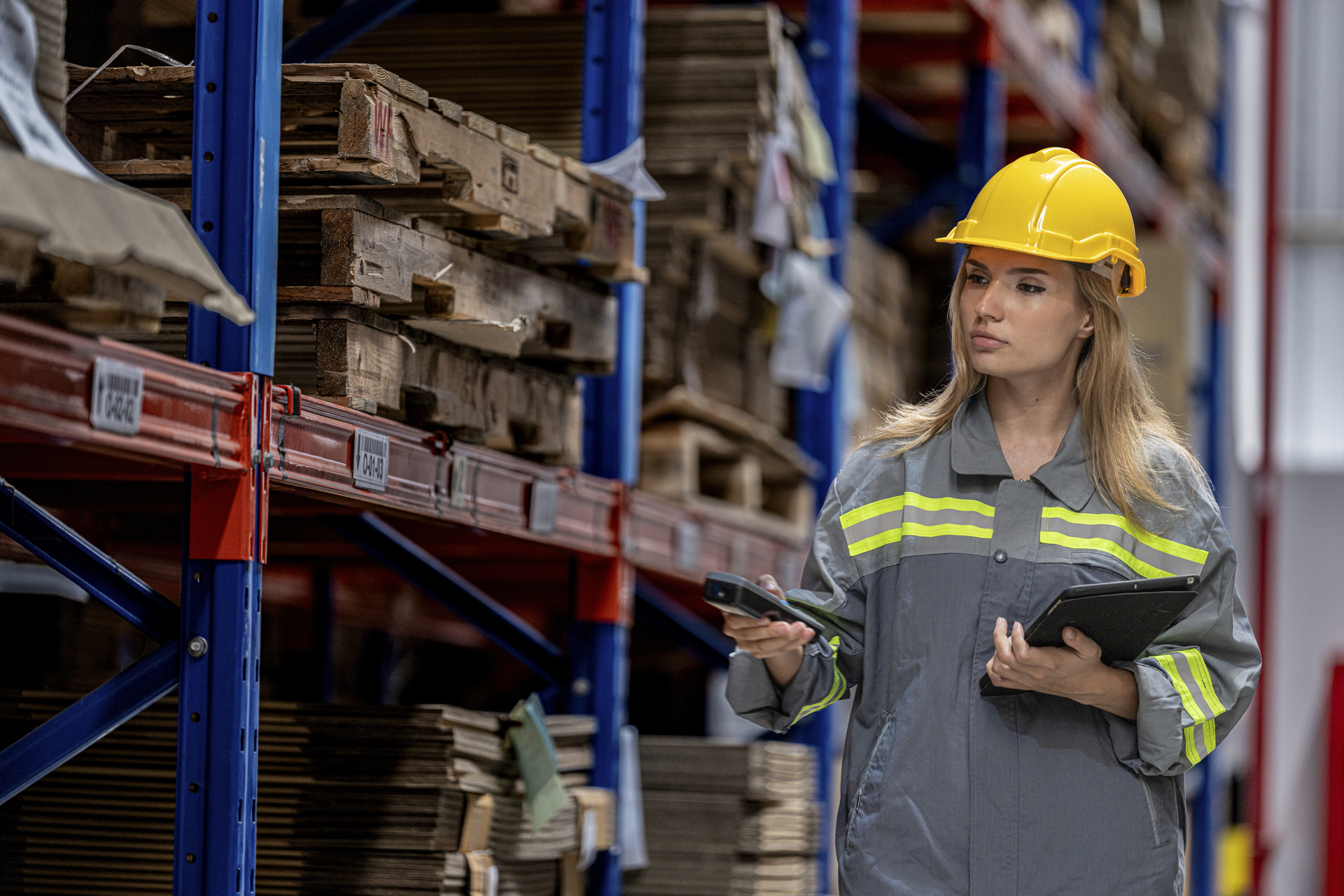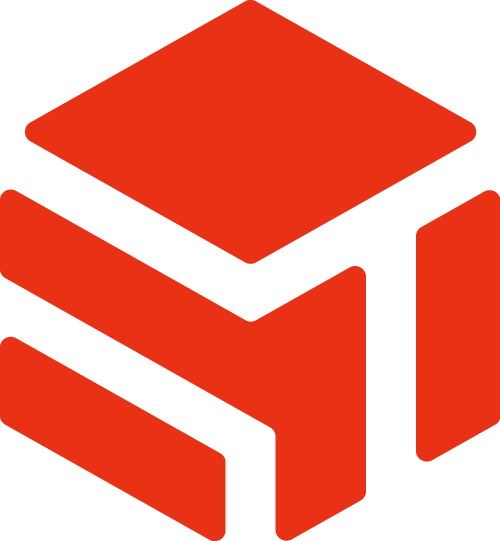When it comes to online shopping, customers want three things: quick delivery, accurate order processing, and easy returns. All three requirements are consistently tied to efficient order fulfillment and remain constant whether they are purchasing from local or global brands.
Meanwhile, the cycle of selling and purchasing is intensifying, both for the industry as a whole and for separate companies as they scale up. As a result, order fulfillment relies more on expertise and tech – which is what today’s 3PL providers bring to the table.
In addition to the comfort of not having to manage everything in-house, eCommerce brands benefit from 3PLs as the automation pioneers within the industry. Choosing an innovative 3PL provider, then, means gaining access to the key automation know-hows, ranging from the latest warehouse technology and robotics to sophisticated systems that keep track of inventory and order statuses across channels.
Let’s have a look at what these know-hows are and where automation can bring the maximum benefit for seamless order fulfillment.
Does lack of automation really affect 3PL efficiency?
Imagine trying to keep track of thousands of items moving in and out of a giant warehouse. It already sounds like a massive headache, right? Now, each of these items is different, and we call them SKUs (Stock Keeping Units). The more types of items (or SKUs) a warehouse has, the trickier it gets to manage everything.
Without 3PL automation, workers in their warehouses can spend hours searching for products because there’s no smart system telling them the quickest route to find them. This often leads to mistakes such as incorrect item picks, or misplaced or forgotten inventory. This, in turn, leads to delays and incorrect orders, triggering a chain reaction that ends with lower customer satisfaction levels.
At the same time, when there’s no system for accurate inventory management, knowing exact inventory levels becomes guesswork. Manual counting is prone to errors, and it’s challenging to keep real-time updates as products move in and out.
To try to fix these problems, warehouses end up needing more workers just to search for items, write things down, and count everything, which costs a lot of money. But the most serious consequences are for a brand or online store that works with 3PLs that lack in tech capacities.
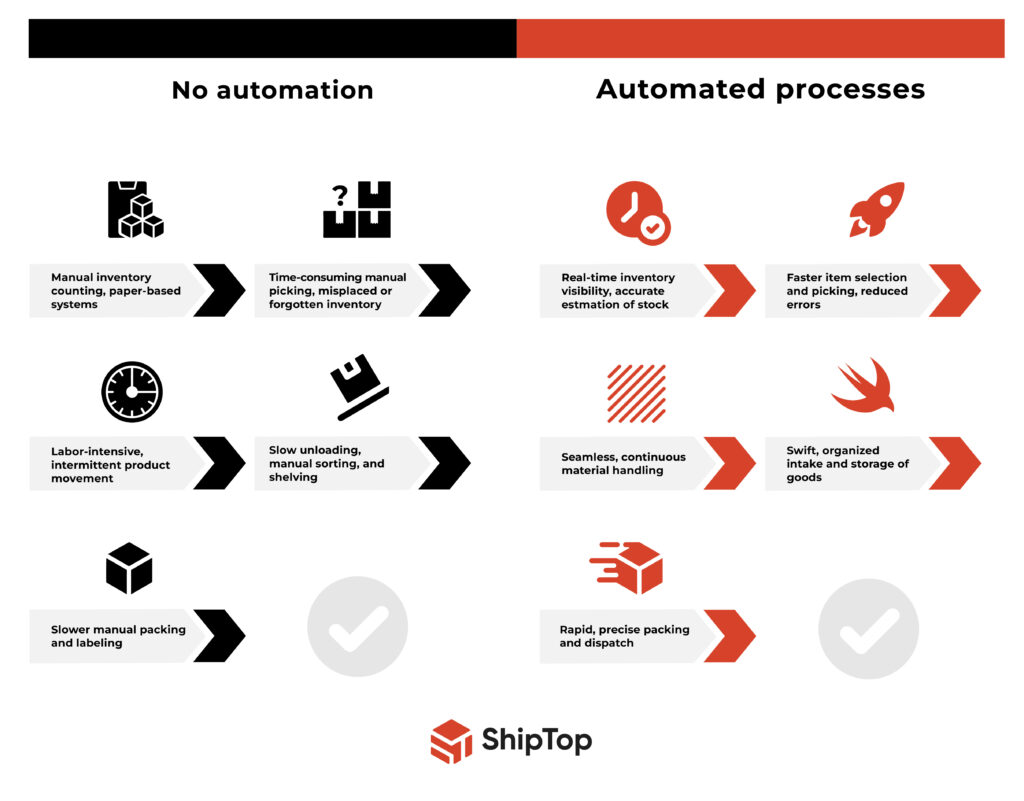
A commonly accepted fact is that manual order processing can slow fulfillment times, but in reality, this may be up to 50%, causing major delays during busy periods.
Accordingly, when a brand (or its 3PL partner) with insufficient automation capabilities gets more orders, especially during busy times like the holidays, it can be hard for them to keep up because they’re not set up to handle the increase efficiently.
This can also make things more expensive to run, cause delays in getting orders out, and upset customers when their purchases don’t arrive on time or there are mistakes with their orders, which, of course affects both retention and conversion of new customers.
Finally, without the right technology, the 3PL provider can’t grow with the brand, limiting the brand’s potential to expand and reach more customers in the future.
💡Industry stats reflect this importance: According to 3PLWorldwide, 93% of those who use 3PL services value strong IT capabilities.
Key areas of automated order fulfillment
3PL providers know how extremely important tech is for eCommerce brands. As a result, investing in 3PL automation becomes crucial for them to stay competitive.
Now over a third of the money in logistics and fulfillment goes into automation, making it the biggest area of spending. In the next five years, 25% of respondents plan to spend $25-99 million on it.
This shows a big commitment across providers to improve operations with 3PL technology.
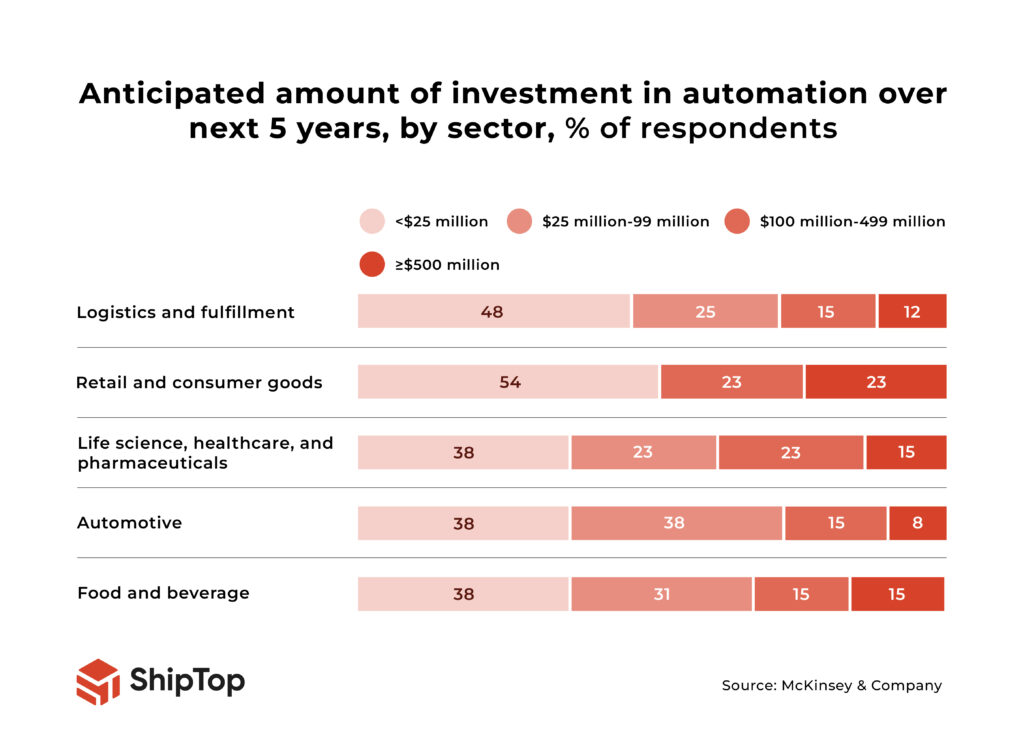
But automation isn’t only about making warehouse operations faster; it’s about enhancing every step of the logistics process, from managing inventory to efficiently shipping out orders.
A 3PL technology for automated fulfillment includes hardware, like conveyor systems and robotic pickers, with systems such as inventory management and order processing platforms.
The hardware helps handle big orders and tasks easily, and the software gives important updates on inventory and orders in real time. Together, they make the work flow smoothly, combining physical tasks and planning. By adopting these technologies, logistics becomes more accurate, quicker, and less likely to have human mistakes.
The key areas of interest are as follows:
- Warehouse management
- Inventory management
- Order processing
- Shipping
- Return management
Types of 3PL technology solutions
What are the technologies in question, though? McKinsey have analyzed the current development and adoption levels for the key tech innovations in warehousing, grouping them into several categories. The most widely adopted and well-developed block of technologies are comprehensive systems like WMS, OMS, etc.
There are various technologies designed specifically for warehouse tasks (picking, packing, labor and asset tracking, space utilization, etc.). All of them are crucial for warehouse efficiency but systems like OMS and inventory management systems (let’s refer to them as ‘fulfillment systems’) are the exact component that helps to integrate these activities into a cohesive workflow, providing real-time data and synchronization of various processes, enabling fast and informed decision making.
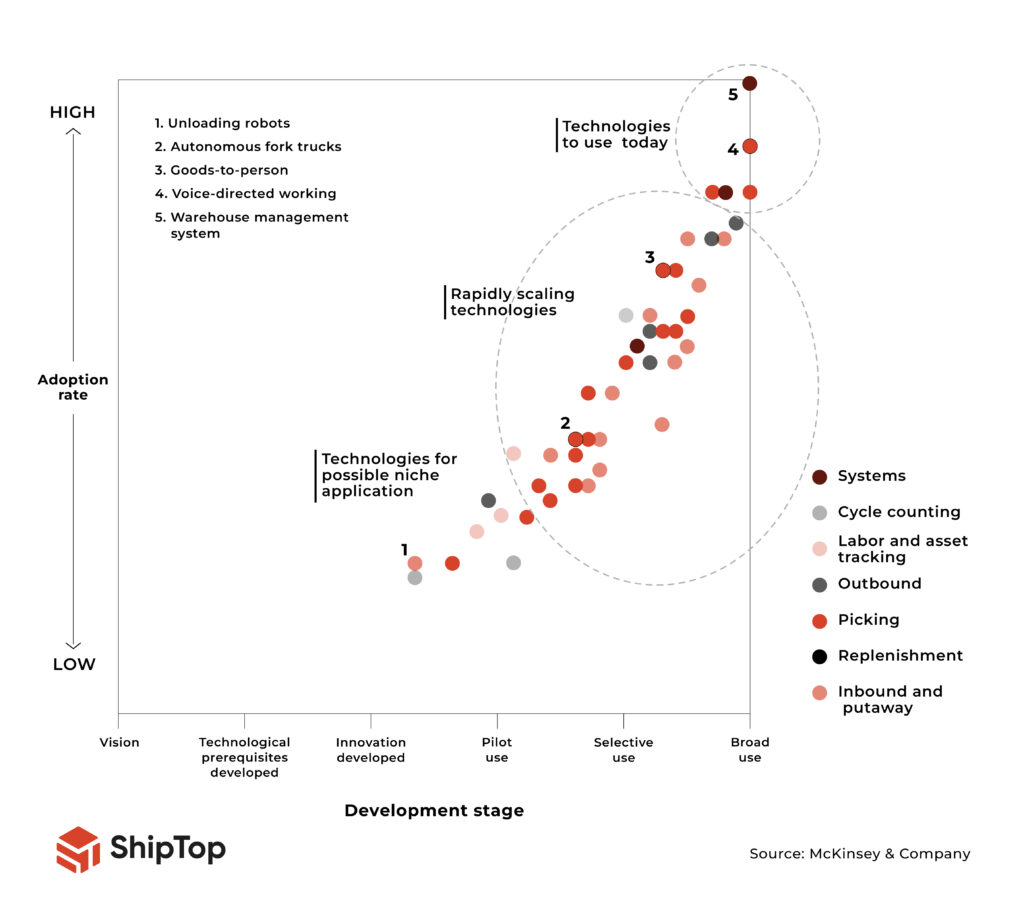
Automated Fulfillment Systems
- Warehouse management systems (WMS): Provide real-time data on inventory levels, item locations, and shipping schedules to enhance efficiency and accuracy in warehouse operations.
- Inventory management systems: Prevent shortages and overstocking by constantly monitoring inventory levels, ensuring that the right amount of stock is available to meet demand.
- Order management systems: Manage the entire order lifecycle – from placement to delivery – by tracking orders and ensuring that all details are correct, thus improving customer satisfaction and operational efficiency.
Warehouse Technologies
- Robotic picking: Robots that automate the packing of items into boxes, tailored to the size and weight of the items, ensuring efficient use of packaging material.
- Picking and packing systems: AI-powered robots that automate the packing of items into boxes or virtual assistants allowing to pack goods according to the size and weight of the items, ensuring efficient use of packaging material.
- Automated storage and retrieval systems (ASRS): Use automated machinery to store and retrieve goods from specific locations within the warehouse, increasing speed and accuracy.
- Barcode and RFID systems: Barcodes or RFID tags allow to quickly and accurately scan products, simplifying inventory management, order picking, and shipping processes.
What tech capabilities to look for in a 3PL provider?
Now it’s clear that when picking a 3PL, the tech side really matters, but based on what criteria to choose one? There are several factors, from the choice of tech capabilities (“toolkits”) to the more general considerations.
This is where the more global questions start to really matter, namely:
- integrating the 3PL-operated tech with your online store, multiple sales channels and your digital ecosystem in general;
- whether or not the 3PLs technologies are scalable (which, in practice, means cloud infrastructures, EDI, etc.)
Let’s now have a look at several most important aspects to pay attention to when choosing an innovative 3PL provider for eCommerce.
Integration with existing systems
When your internal systems aren’t integrated with your 3PL’s systems, you may have to manually notify the fulfillment center of each order. This can lead to mistakes and slow down the process. With proper integration, the fulfillment center gets immediate notification when a customer places an order. This allows them to start preparing the product for shipment right away. This results in faster deliveries, fewer errors, and ensures your inventory levels are always accurate.
Automated order fulfillment
Minimized human intervention means reduced potential for errors and greater speed, which is especially important during peak periods. For instance, an innovative 3PL provider employing an automated sorting system with barcode scanners can automatically route items to the correct shipping lanes based on destination and service level, with the data collected being converted into guaranteed real-time inventory updates.
eCommerce integrations
Integrations with your chosen eCommerce platforms (Shopify, WooCommerce, Magento, etc.) can make things easier due to automatic order import and instant updates on shipping status across multiple channels. Moreover, good eCommerce integrations often come with features like automated shipping label generation and tracking number updates.
Scalability
The more innovative 3PL providers achieve scalability through cloud-based infrastructure, modular software architecture, and APIs. This ensures that their IT resources can match the levels of demand your business is experiencing at any point, ramping up to handle the bigger volumes without sacrificing performance.
Benefits of partnering with a innovative 3PL provider
In practice, the benefits of choosing an innovative 3PL go beyond the more or less obvious cost-efficiency considerations. Apart from simply benefiting from the provider’s digital capacities at the immediate level (i.e. letting things happen faster and cheaper), this is also a valid strategy to tap into the recent findings of digital transformation in general, which allows companies to decide whether they want to develop them in-house, or would rather outsource them and reap the benefits.
1. Cost savings
Cost savings are one of the immediate effects, and they come in several directions. First of all, automation means fewer paid hours of human work, both within the client organization and for the 3PL. Seeing as how 3PLs are facing tough competition, their automation-fueled efficiency (picking and packing, reporting, etc.) feeds their ability to offer competitive pricing. Additionally, since tech allows redistributing inventory across warehouses and choosing the optimal locations, this means smaller distances for the actual delivery, meaning the transportation costs less for the business and the end customer.
2. Save time and reduce manual errors
Automated order notifications are one of the “black holes” notorious for draining resources, including time itself. Since we’re now living in the world of same-day delivery promises (or at least fast delivery expectations), doing things manually often results in human error. This, in turn, impacts customer retention and conversion at the same time, so automation that certain 3PLs provide is a welcome change.
3. Better inventory management
With proper automation functionalities, 3PLs can provide the possibility to monitor stock levels across multiple locations. This, in turn, allows not just to track the inventory levels to avoid stockouts, but also implement auto reordering when necessary.
4. Valuable metrics
Automated processes also make it possible to generate reports on key metrics like peak shopping times, sales channels, and regional order trends, that can be used by marketing and for general business strategy.
Tech-enabled 3PL support your omnichannel growth
Finally, it would be unfair not to say a few words about the specific demands of omnichannel eCommerce and what technological capacities 3PLs use to help solve common problems here.
- Inventory updates and synchronization
According to Shopify, only 31% of brands can show store inventory online, and the more channels you have to juggle, the more difficult it becomes to keep track of inventory manually. A tech-savvy 3PL provider like ShipTop can alleviate this problem by having a unified platform that updates and synchronizes inventory changes automatically.
- Inventory reallocation
In an omnichannel environment, there may be channel-specific peaks in demand and the changes in the market are more frequent compared to a mono-channel paradigm. This, in turn, means the business needs to balance and sometimes reallocate inventory between the channels, which is next to impossible without an overarching inventory management system.
- Multi-warehouse network management
It is also a good idea to search for a 3PL provider that allows one to manage a multi-warehouse network and can automatically determine the optimal fulfillment location for each order. This, of course, is also only possible if their integrations allow for instant notification of any incoming order.
- Reverse logistics made simple
But once it’s in place, there’s an additional benefit of easier reverse logistics and returns handling, since the system allows to orchestrate returns across channels, not even necessarily through the same channel as the original purchase was made (sort of reversed BOPIS).
Why ShipTop for eCommerce fulfillment automation?
As a leading eCommerce fulfillment provider, and the most innovative eCommerce fulfillment business in 2023, ShipTop utilizes advanced technology to help eCommerce businesses grow.
We leverage multiple technologies in our warehouses, including ones for picking and packing, space optimization, automatic determining of optimal box sizes, etc. to enhance efficiency and optimize warehouse operations.
Meanwhile, our comprehensive digital platform combines a multi-channel order and inventory management system with a fast and reliable fulfillment process, enabling eCommerce merchants to:
- Manage orders easily
- Customize options
- Track inventory in real time
- Receive automatic reorder notifications
- Provide access for an unlimited number of users at no added cost
As part of our commitment to order fulfillment automation, we regularly invest in advanced data analytics, AI-driven logistics, and IoT-enabled warehouse management systems to improve our overall performance.
Get in touch with our team to discover how ShipTop can streamline your shipping and fulfillment processes.

